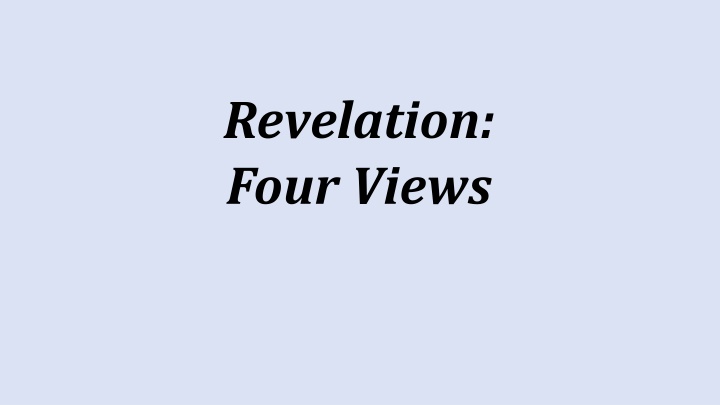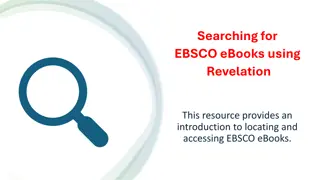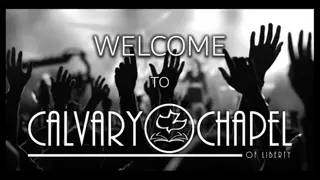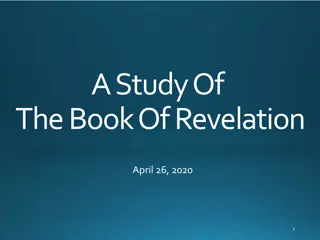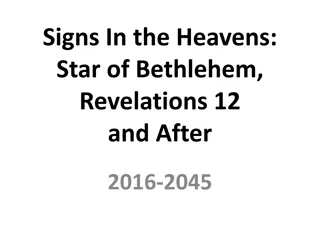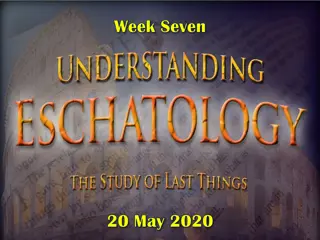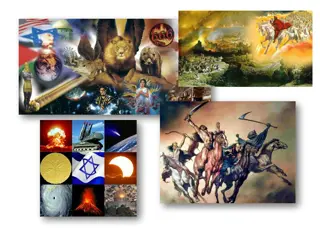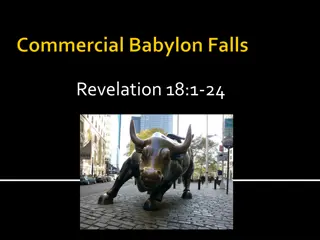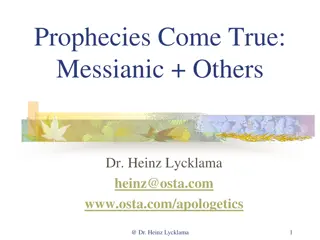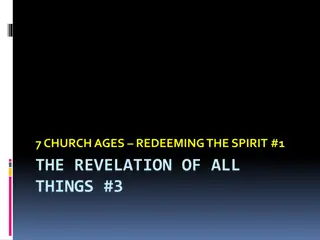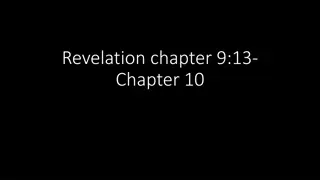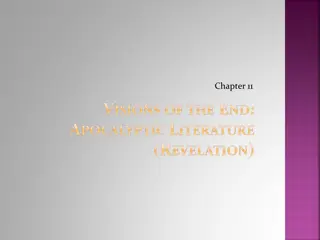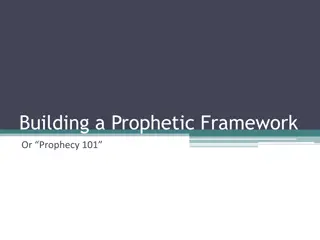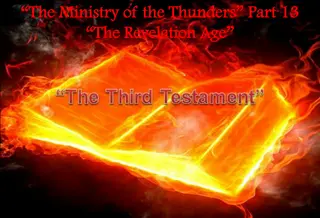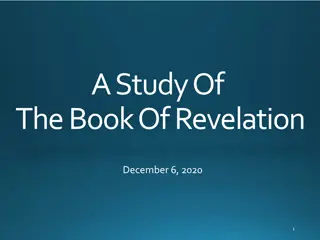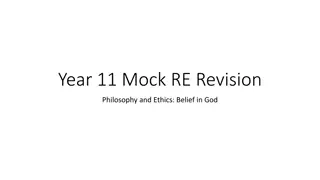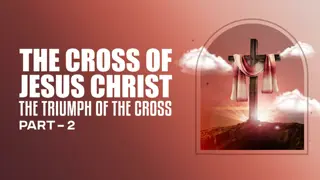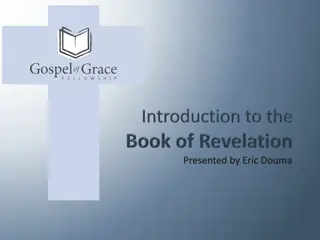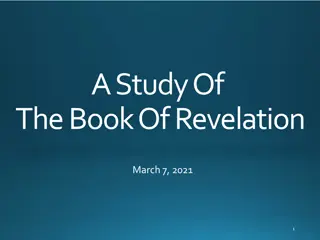Revelation: A Unique and Paradoxical Book of Prophecy
The Book of Revelation stands out as a unique and paradoxical text in the Bible. It is considered the most difficult book, presenting challenges in authorship, historical context, and interpretation. However, it is also the only book promising blessings to those who read and keep its words. This prophetic book is a blend of prophecy, epistle, and apocalypse, foretelling future events in a genuine and comforting manner.
Download Presentation

Please find below an Image/Link to download the presentation.
The content on the website is provided AS IS for your information and personal use only. It may not be sold, licensed, or shared on other websites without obtaining consent from the author.If you encounter any issues during the download, it is possible that the publisher has removed the file from their server.
You are allowed to download the files provided on this website for personal or commercial use, subject to the condition that they are used lawfully. All files are the property of their respective owners.
The content on the website is provided AS IS for your information and personal use only. It may not be sold, licensed, or shared on other websites without obtaining consent from the author.
E N D
Presentation Transcript
Revelation: Four Views
What Kind of Book is the Book of Revelation?
I. A Paradoxical book A. The most difficult book of the Bible. Presents difficulties regarding authorship, date, historical setting, relation to other books attributed to John, acceptance into the canon of scripture and, of course, interpretation of its symbols.
I. A Paradoxical book B. The only book promising a blessing to those who read it and keep its words (1:3).
II. A Unique book The only book in the world that is at once:
II. A Unique book The only book in the world that is at once: a genuine prophecy (1:3)
II. A Unique book The only book in the world that is at once: a genuine prophecy (1:3) "He who prophesies speaks edification and exhortation and comfort to men. (I Corinthians 14:3)
II. A Unique book The only book in the world that is at once: a genuine prophecy (1:3) an epistle (1:4)
II. A Unique book The only book in the world that is at once: a genuine prophecy (1:3) an epistle (1:4) an apocalypse (1:1)
A. As a Prophecy 1. It foretells future events (1:1).
A. As a Prophecy 1. It foretells future events. The revelation from Jesus Christ, which God gave him to show his servants what must soon take place. (Revelation 1:1)
A. As a Prophecy 1. It foretells future events. 2. It "forthtells" Christ's message to the churches (Chapters 2-3).
A. As a Prophecy 1. It foretells future events (1:1). 2. It "forthtells" Christ's message to the churches: Whoever has ears, let them hear what the Spirit says to the churches. (2:7, etc.)
B. As an Epistle to the Seven Churches of Asia 1. It has the form of an epistle (1:4, 11; 22:21);
John, to the seven churches which are in Asia (1:4) write in a book and send it to the seven churches which are in Asia: to Ephesus, to Smyrna, to Pergamos, to Thyatira, to Sardis, to Philadelphia, and to Laodicea. (1:11)
The grace of our Lord Jesus Christ be with you all. Amen. (22:21)
B. As an Epistle to the Seven Churches of Asia 1. It has the form of an epistle (1:4, 11; 22:21); 2. It is the only epistle dictated directly by Jesus;
These things says He who holds the seven stars in His right hand, who walks in the midst of the seven golden lampstands (2:1)
These things says He who holds the seven stars in His right hand, who walks in the midst of the seven golden lampstands (2:1) These things says the First and the Last, who was dead, and came to life (2:8)
These things says He who holds the seven stars in His right hand, who walks in the midst of the seven golden lampstands (2:1) These things says the First and the Last, who was dead, and came to life (2:8) These things says He who has the sharp two- edged sword (2:12)
B. As an Epistle to the Seven Churches of Asia 1. It has the form of an epistle (1:4, 11; 22:21); 2. It is the only epistle dictated directly by Jesus; 3. It is primarily relevant to original readers in their life setting;
I know your works, your labor, your patience Nevertheless I have this against you, that you have left your first love. (2:4)
I know your works, your labor, your patience Nevertheless I have this against you, that you have left your first love. (2:4) I know your works, love, service, faith, and your patience Nevertheless I have a few things against you, because you allow that woman Jezebel, who calls herself a prophetess, to teach and seduce My servants (2:19-20)
B. As an Epistle to the Seven Churches of Asia 1. It has the form of an epistle (1:4, 11; 22:21); 2. It is the only epistle dictated directly by Jesus; 3. It is primarily relevant to original readers in their life setting; 4. It has abiding relevance, secondarily, to all readers in like circumstances.
He who has an ear, let him hear what the Spirit says to the churches. (2:7, 11, 17; 29; 3:6, 13, 22)
C. As an Apocalypse, it is the "unveiling" of Jesus Christ.
C. As an Apocalypse, it is the "unveiling" of Jesus Christ. The Revelation [Gr. apocalypsis] of Jesus Christ, which God gave Him to show His servants things which must shortly take place. And He sent and signified [give a sign or token] it by His angel to His servant John (1:1)
Apocalyptic Literature In the two centuries just preceding the time of Christ, the Jews produced many uninspired works which resemble the book of Revelation in style or genre. Because of this resemblance, scholars refer to these books as Apocalyptic Literature. It is probable that this genre arose in imitation of inspired books like Isaiah, Ezekiel, Daniel, Joel and Zechariah.
Apocalyptic Literature All such books shared certain characteristics:
1) They claimed to be written by famous individuals of the past (e.g., Ezra or Enoch);
1) They claimed to be written by famous individuals of the past (e.g., Ezra or Enoch); 2) They were highly symbolic, containing dreams or visions using animal symbolism, mythical, astral or catastrophic images to describe history, the unseen realm, or the future;
Apocalyptic Prologue to Esther (alleged dream of Mordecai): "Behold, earthquake, tumult upon the earth! And behold, two great dragons came forward, both ready to fight, and they roared terribly. And at their roaring every nation prepared for war, to fight against the nation of the righteous. And behold, a day of darkness and gloom, tribulation and distress, affliction and great tumult upon the earth noise and confusion, thunders and
1) They claimed to be written by famous individuals of the past (e.g., Ezra or Enoch); 2) They were highly symbolic, containing dreams or visions using animal symbolism, mythical, astral or catastrophic images to describe history, the unseen realm, or the future; 3) The authors are guided around by angels who explain the meaning of visions.
Apocalyptic Prologue to Esther (continued): And the whole righteous nation was troubled, they feared the evils that threatened them, and were ready to perish. Then they cried to God and from their cry, as though from a tiny spring, there came a great river, with abundant water, light came, and the sun rose, and the lowly were exalted and consumed those held in honor.
Apocalyptic Epilogue to Esther (by same author): I remember the dream that I had concerning these matters, and none of them has failed to be fulfilled. The tiny stream which became a river, and there was light and the sun and abundant water - the river is Esther, whom the king married and made queen. The two dragons are Haman and myself. The nations are those gathered to destroy the name of the Jews. And my nation, this is Israel, who cried out to God and were saved.
In the following respects, Revelation is unlike the uninspired apocalyptic books:
In the following respects, Revelation is unlike the uninspired apocalyptic books: a. It claims inspiration as a prophecy.
In the following respects, Revelation is unlike the uninspired apocalyptic books: a. It claims inspiration as a prophecy. b. It identifies by name its true author (John), rather than adopting a pseudonym.
In the following respects, Revelation is unlike the uninspired apocalyptic books: a. It claims inspiration as a prophecy. b. It identifies by name its true author (John), rather than adopting a pseudonym. c. It makes a moral appeal and calls for repentance.
Elements of Apocalyptic Symbolism in Revelation People, nations, spiritual personages depicted as animals (e.g. a Lamb, a dragon, beasts, locusts, etc.);
Elements of Apocalyptic Symbolism in Revelation People, nations, spiritual personages depicted as animals (e.g. a Lamb, a dragon, beasts, locusts, etc.); Two women (harlot and bride) are two cities (Babylon and New Jerusalem);
Elements of Apocalyptic Symbolism in Revelation Symbolic names [e.g. Jezebel (2:20), Egypt and Sodom (11:8), and Babylon (17:5)]
Elements of Apocalyptic Symbolism in Revelation Symbolic names [e.g. Jezebel (2:20), Egypt and Sodom (11:8), and Babylon (17:5)] Frequent cosmic disruptions: sun & moon darkened, stars falling, 100-pound hailstones
